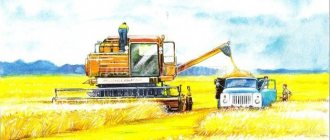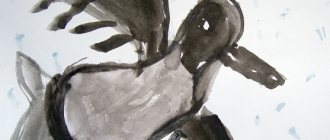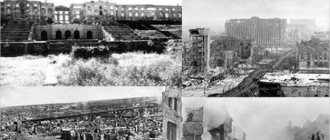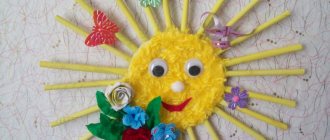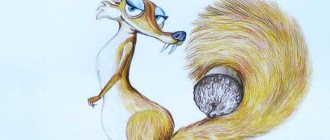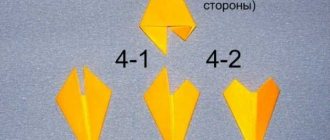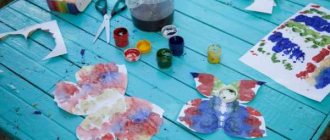Project. Bread is the head of everything! | Country of Masters
Good day to all! Last year, my son (a second grader at the time) did (with my help) a project on the theme “Bread is the head of everything.” The project was made in PowerPoint; when exported to another format, the quality of the slides deteriorated. For the project and for the way his son defended it, Dima received a finalist certificate (the project was one of the best in the school, there were no winners this time). The presentation of the project required about 12 - 15 slides (preferably without text), the speech should take about 10-15 minutes. In this regard, the text was created according to the principle - short and clear. And there is no text on the slides, so each slide will accompany the speech that Dima spoke at his defense.
Slide 2 Purpose: to get acquainted with the process of growing bread; talk about the value of bread and respect for it and the people who raised it. Bread is a symbol of well-being and prosperity.
Bread on the table is wealth in the house.
Slide 3 Bread provides our body with proteins, carbohydrates, and beneficial microelements, which are necessary for brain function. Bread contains vitamin B, which strengthens the nervous system, memory, and improves digestion. Bread crust helps our body resist many cancers. Medical scientists believe that an adult should eat 300-500g of bread per day, or 700g during hard work. Children and teenagers need 150-400g of bread. A person gets almost half of his energy from bread.
Slide 4 Scientists believe that bread is over 15 thousand years old. True, bread in those ancient times was not much like today. The first bread was a liquid pulp made from cereals and water. In ancient Egypt, 5-6 thousand years ago, there was a kind of rebirth of bread. There they learned how to loosen dough using the fermentation method.
In medieval England, wealthy people used black bread as plates: large loaves of bread were cut into large slices, and a small depression was made in the middle of the piece into which food was placed. After lunch, these “plates” were collected in a basket and distributed to the poor.
Slide 5 You can’t get rye bread, loaves, rolls while walking. People cherish bread in the fields, they spare no effort for bread. (approx. author of poems Y. Akim) Bread appears on our table thanks to the hard work of grain growers. Strong machines help people grow and harvest bread. In the spring, tractors go out into the field. A plow is attached to the tractor, the plow turns over the earth. It comes out in large, dense clumps. Then the tractor pulls a harrow, similar to a large rake, which loosens the ground. Then seeders go out onto the plowed field and sow in three rows at once.
Slide 6 Spikelets grow from grains. Each ear contains many new grains. The grain fields are like the sea. The wind blows and the ears of corn sway like waves. The ears are golden, it's time to harvest. You must not hesitate so that the grains do not fall to the ground. Harvesters are out in the field, cutting the ears, threshing them, shaking out the grains from the ears.
Slide 7 Machines deliver grain to a mechanized conveyor for cleaning and drying. Then the grain is taken to the elevator - this is a large granary. Here the grain is ground - ground and flour is obtained. From a grain of wheat you can get about 20 milligrams of first grade flour. Baking one loaf requires more than 10 thousand grains.
Slide 8 Flour is supplied to bakeries and bakeries. Here they make bakery and confectionery products from it, which we then buy in stores. This is the long and difficult path that bread takes from the field to our table.
Slide 9 Today, the names of types of bread and bakery products number in the hundreds. (approx. list of names, for example, some names are shown on the slide)
Slide 10 Our main breadwinners are wheat and rye. White bread, rolls, cookies, and bagels are made from wheat flour. And they also make semolina from wheat. Black bread made from rye flour. The ear of wheat is thicker, and the ear of rye is thinner. Wheat grains are rounder, and rye grains are longer.
Slide 11 I decided to germinate wheat grains at home and kept a calendar of observations. Here are my observations. (note: all observations were photographed and signed, when and what happened to the sprouts, Dima commented on all this during his defense)
Slide 12 It was not possible to grow ears of corn at home, but I watched the ears of rye and oats, which we planted and raised with my grandparents, grow in the summer. And we planted them in the fall before winter. Our photographs show how the spikelets changed at different times. My mother and I also made a visual aid with the stages of the birth of bread.
Here I will step back a little from the project itself and demonstrate the very visual aid mentioned above. From the grains ears grow, from the ears we get grain, from the grain we get flour, and from the flour we make baked goods.
Wheat grains, ears, flour - real, baked goods made from salt dough, dried, painted, varnished.
Everything was arranged in the form of a stand.
Stand size.
Closer.
Many said that it turned out natural.
Let's continue.
Slide 13 Today you can buy as much bread as you want in the store, but there was a time when a piece of rye bread was more valuable than gold. During the Great Patriotic War, bread was baked from husks, grass, quinoa, bran, and sawdust. And they gave us a small piece of this bread, 125g, for the whole day. People understood that bread was their life. This piece could hardly be called bread, because it contained only 5 grams of flour, the rest was impurities. The Museum of the History of Leningrad contains a piece of moldy bread the size of a little finger. This was the daily ration for the residents of the city besieged by the Germans; there were no other products. While working on the project, I found wonderful poems: A boy who kicks bread with his foot, A boy who knows no hungry years, Remember that there were dashing years. Bread is life, not just food. They swore by bread, They died for bread, Not so that they could play football. Folk wisdom is hidden in the word. This is what our people say: “If you don’t value bread, you’ve ceased to be a human being.” (approx. author of poems Bobo Hoxha)
Slide 13 In Russia, according to a long-standing custom, dear guests are greeted with bread and salt. There are also a number of signs; it is believed that people who break bread become friends for life. It was considered the greatest sin in Rus' to drop at least one crumb of bread, and an even greater sin was to trample this crumb underfoot. (note: there is a speaker icon on the slide - to this slide we added an excerpt from the song (chorus) by Olga Voronets “Bread is the head of everything”, namely these lines: You remember, son, the golden words - Bread is the head of everything, Bread is the head of everything! ) Take care of the BREAD! BREAD is our wealth! Thank you for your attention!
stranamasterov.ru
Progress of the lesson
Educator: Pictures will help you determine the topic of today’s lesson . I will ask you to come up and choose one fragment. Now look at the other side. See, "shirts"
the pictures have different colors.
Please, those guys who have pictures with a blue “shirt”
, go to the table marked with a blue circle;
those who have “shirt”
- go to the
“yellow table”
; etc.
So, guys, take a close look at the pictures you got. Go to other tables. What do you think we will talk about in class ? Correct about bread .
Guys, I brought reproductions of paintings by Russian artists to our lesson . In Stozharov's " Bread , salt and brother"
and Ilya Ivanovich
Look at this picture, what can you say about it?
Children's answers: That's right, it's a still life.
Let's remember what a still life is. Still life is a genre of art that depicts inanimate objects in specially created compositions.
What other genres of art do you know?
Correct: Landscape and portrait.
Landscape is an image of nature or some area (forest, field, grove, etc.)
Educator: Let's look at our still life and what is drawn on it.
How the artist arranged his objects. Isn't it nice to see such an abundance of bread and pies? It seems that the painting emanates a delicious smell of freshly baked bread , rolls, and fluffy dough.
Guys, let's be artists and draw a still life, but to start drawing we need to stretch our fingers.
Knead the flour into the dough, squeeze and unclench your fingers.
And we made them from the dough: They clap their palms and “mold”
.
Pies and buns, Alternately bending fingers
Sweet cheesecakes, starting with the little finger.
Buns and rolls -
We will bake everything in the oven. Turning both palms up.
Delicious! Stroking the belly.
Educator: First, you and I will draw a sketch with a simple pencil. What do you see in front of you? (Children's answers)
.
First, we will draw the surface of the table. (Children draw together with the teacher)
Then we see that there is a basket of bread . What types of baked goods do you see in the basket? (Children's answers)
.
Pay attention to what lies next to the basket. (Children's answers)
.
Well done guys, you made wonderful pencil sketches.
While drawing, soft music is turned on. P. I. Tchaikovsky “July, August”
from the series
"Seasons"
.
Now we can move on to working with colored pencils. Please tell me what colors we will use? (Children's answers)
.
Did you enjoy drawing a still life today? What did you find difficult?
Well, our lesson has come to an end . Guys, you turned out wonderful still lifes. Let's organize an exhibition for our parents. (children talk about their drawings, what they liked and what caused difficulties)
The seed is growing (They squat, clasping their knees with their hands)
The seed is growing - (Squatting, hands pulled up)
Reached for the sun. (Stand up, stretch on tiptoes, hands up)
It plays with the breeze, (Hands up, swaying gently from side to side
How to draw bread | Just crafts
Bread has been an integral food product since ancient times. Therefore, you can often hear the expression that he is the head of everything. Not a single dinner or feast is complete without it.
So let's learn how to draw bread in the form of a peasant loaf with sesame seeds, which will lie on a cloth or towel. To give a natural natural shade, we use brown and yellow pencils, which we apply directly to the entire product.
Materials for drawing bread:
- paper;
- black and colored pencils;
- liner (thin black gel pen).
Drawing bread in stages:
Bread can have different shapes. Let's depict it in the form of a loaf, which will have beautiful tubercles with cuts. First, let's draw an oval, which will become an outline.
Then we form the top part of the bread, which has a delicious top crust. To do this, draw three tubercles. From them we draw stripes in the center.
Then we remove the auxiliary lines of the bread contour with an eraser and draw fabric around it (optional). We will depict it using lines and arcs to show the folds.
Finally, add small sesame seeds to the top of the bread.
Now we use yellow and light brown pencils to apply the base shade on the food product.
For a beautiful and appetizing color of crispy crust on bread, you should use darker brown shades. We apply them both to the bottom of the object and to the top. We work on the depressions between the tubercles with dark shades to get a shadow in these places.
Use a blue pencil to color the fabric. For a more saturated color in shadow areas, use a purple tint.
We darken the entire drawing with a black pencil to get a shadow in certain places.
We also work out the drawing with a liner with a black rod for the outline. Also, let's not forget about the small grains on the top of the bread, which should also be drawn.
What came out was this appetizing drawing of bread on a bluish fabric, which was achieved thanks to step-by-step drawing and the necessary materials. In the finished illustration you can add ears of wheat, a towel and a wooden table.
prostopodelki.ru
Bread in a basket
Drawing in the senior group on this topic can be planned as follows:
1. First, children depict a basket. This can be an ordinary product woven from twigs. The child first draws the contours with a simple pencil, dividing it into sectors. Only then are small details painted over, alternating light and dark elements with each other.
2. Then, after complete drying, the bread and bagel are painted, shading the curves of the products with a lighter shade.
3. You can insert several spikelets into the basket in the background. To do this, you need to draw with a simple pencil and then paint, also alternating colors.
Such drawing in the older group on the topic “Bread” can be done using colored pencils or wax crayons. Because there are a lot of small details.
Please note: if you want to draw such a picture at home with your child, then five-year-old children should already understand the spatial arrangement of objects. What is closer is drawn in a larger size, what is further away is drawn in a small size. To draw a basket, use such an angle when the front of the wallet is located lower, not at the same level as the back side. The inside of the container is visible. You can draw a handle for it, or you can put a napkin on the bottom of the basket and draw the corners of the fabric hanging from the middle of it.
Bread is the head of everything » MBDOU kindergarten No. 38
Teacher of the junior mixed preschool group Svetlana Alekseevna Bogush
At all times, bread has been and remains a symbol of life, prosperity and prosperity. Bread should always be on the table - both on weekdays and on holidays - in the place of honor. Bread is the main and most common food product. It’s not for nothing that folklore is so rich in proverbs about bread: “Bread is the head of everything,” “It’s not the fur coat that warms, but the bread,” “Illness is not a problem if you have bread and water,” “Bread will feed you, water will wash you,” says popular wisdom.
This valuable product accompanies us from birth to old age; bread is a source of strength and energy. But many modern children often do not realize how long a journey it takes to get to the table, how much work people need to put in to sow, grow, and then bake bread.
The children of the junior mixed preschool group got acquainted with bread and bakery products. There were many conversations about bread, solving riddles, watching presentations, in which the teacher drew the children’s attention to the beneficial properties of bread.
Parents of the students were invited to participate in a creative competition of child-parent drawings on the theme “Bread is the head of everything!” This competition was aimed at drawing children's attention to the efforts that make bread appear on our table, and at helping to develop a caring and respectful attitude towards bread among the younger generation.
It is important to always remember that bread is the main food product that provides a significant amount of energy and nutrients necessary for the body; everyone needs it!
xn—-38-53dwcf1akj7fei.xn--p1ai
Summary of a drawing lesson in the preparatory group “Wheat field. The spikelets are golden. Bread"
Irina Sergeevna Panova
Summary of a drawing lesson in the preparatory group “Wheat field. The spikelets are golden. Bread"
Integration of all educational areas.
Children's age: 5-6 years.
Goal: To consolidate knowledge about the genre of landscape painting. Learn to choose the appropriate color scheme.
-Learn to convey the shape, color and size of objects in a drawing;
-Learn to harmoniously place an image on a sheet of paper;
-To consolidate knowledge about the genre of landscape painting.
-Develop the ability to draw a background , depicting heaven and earth;
-Develop a vision of aesthetic beauty in the landscape.
-Develop the ability to work with paints carefully.
Preliminary work: View the presentation: did the bread come to our table from ?”
Examination and
drawing by points of an ear , grain, sheaf of ears .
Equipment and materials:
Reproductions of paintings depicting wheat fields , wheat ears .
Landscape sheets of A4 format, gouache, brushes, brush stands, jars of water, rag napkins.
Preview:
Department of General Education
of the Rtishchevsky District of the Saratov Region
Municipal preschool educational institution "Kindergarten No. 12 "Zvezdochka". G. Rtishchevo, Saratov region"
Topic: “Bread is the head of everything”
Educator: Kolomiets V.E.
Abstract drawing “Bread is the head of everything”
Goal: To teach children unconventional ways of drawing an ear of wheat.
expand and deepen children’s knowledge about a wheat ear and its appearance.
strengthen your drawing skills using brush bristles.
— increase the motivation of visual activity through awareness of its moral significance; improve gross and fine motor skills.
activate adjectives in children’s speech (yellow, prickly, golden).
Educational objectives: to cultivate independence and focus in work, the ability to complete a job started, accuracy when working with paints. Cultivate a caring attitude towards bread.
The teacher tells the ancient legend about the ear of bread:
— In ancient times, when God himself walked the earth, people’s lives were easy and well-fed. It was summer all year round. When needed, it rained, when needed, the sun shone. Fruit trees grew in the forests. The animals were docile, and all fed on grass. People knew no disease, no troubles, no hunger. The ear of grain was very large - there was almost no stalk, the grains started from the ground itself, and each grain was the size of a bean. There was so much bread that no one valued it. One day God walked the earth and saw how a mother wiped a soiled child with the edge of freshly baked bread and at the same time refused food to the wanderer. God got angry, ascended to heaven and deprived people of bread. The earth became like stone, the rivers dried up, the grass withered. Hunger has set in. Then the cat and dog went to God to ask for bread. He took pity and allocated a small ear on a long stem for the cat and dog's share. God made it so that summer began to occupy only half of the year. Winter is for people, and summer is for animals. When people baked fresh bread, they gave the first piece to cats and dogs. Now tell me, what does the legend teach?
Educator: guys, guess the riddle, “a house grew up in a field, the house is full of grain” (ear of grain). Here is the spikelet as our guest today, let’s tell you what we know about it. Where does the spikelet grow? What plants still grow in the field that have spikelets?
Children: wheat, rye, barley.
Educator: guys, let's look at the picture showing a wheat field. What's on the spikelet?
Children: grains (the teacher demonstrates a natural ear of wheat)
A grain has fallen into the ground (children crouch),
It began to germinate in the sun (arms above head).
The rain watered the ground, and the sprout grew (the children get up slowly).
He was drawn to the light and warmth, and turned into a handsome man.
Educator: children, let's sit down at the table and try to draw a wheat field (first we draw a stalk, and then blot the bristles of the brush.
The teacher asks the children to imagine that he is a spikelet, and they are grains. Children slowly gather in a circle on the carpet, with the teacher in the center.
— Guys, tell me what is made from wheat grains? (different types of flour)
-What are they made from flour? (bakery products)
- Today our spikelet has prepared bread for you.
- When you eat, remember the legend of the ear of bread.
Source
